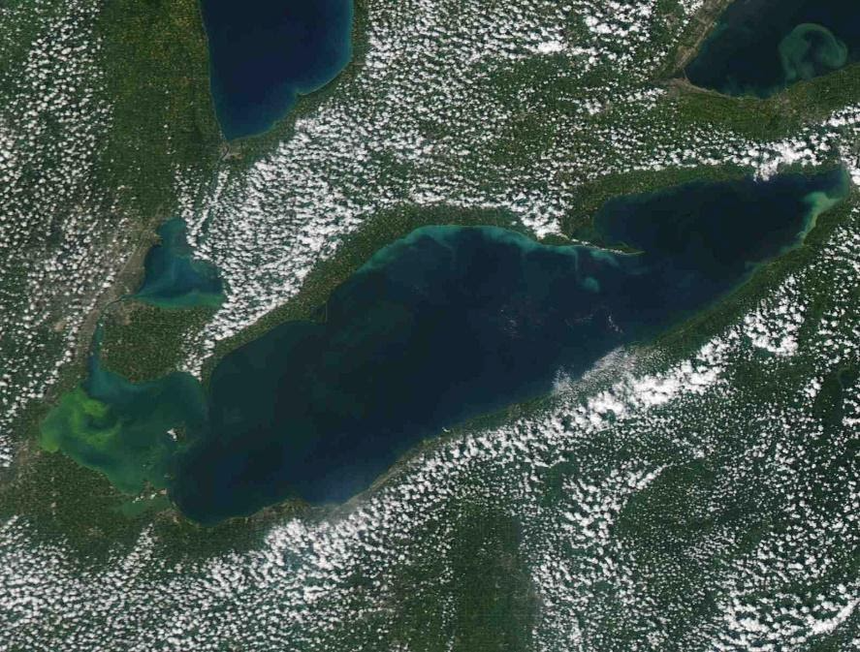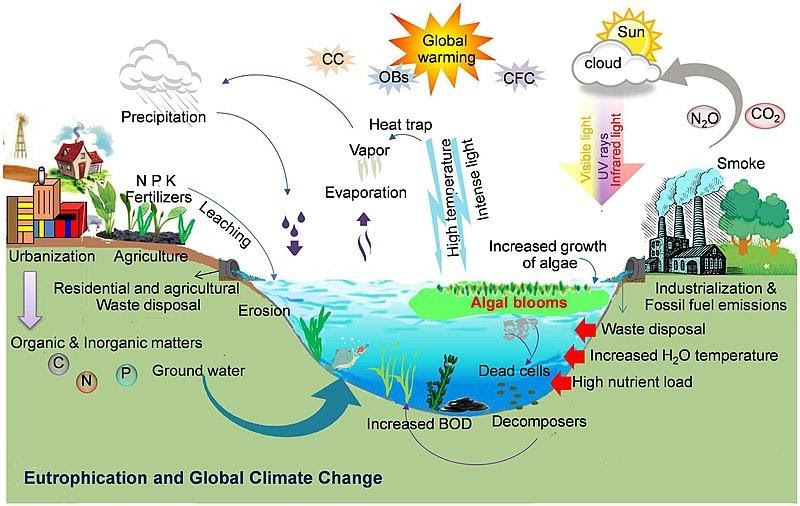Eutrophication - Definition, Classification, Factors, Effects, FAQs
What is Eutrophication?
Eutrophication meaning is a term derived from the Greek word eutrophos, which meaning "well-nourished," and it has now become a serious environmental concern. Phosphates and nitrates forming by lawn fertilizers, in particular, leach into lakes and rivers, increasing the growth of algae and other plant life that consume oxygen from the water, resulting in the death of molluscs and fish. The culprits are cow manure, detergents, human waste, and agricultural fertilizer. It has become a source of environmental concern.
According to the major water quality governing organizations, it is causing water quality degradation and is one of the major challenges to improving water quality. Eutrophication has harmed 53 percent of European lakes, 54 percent of Asian lakes, 48 percent of North American lakes, 41 percent of South American lakes, and 28 percent of African lakes, according to the State of the World's Lakes Survey. This material enters the ecosystem mostly through runoff from land, which brings waste and products of terrestrial creatures' reproduction and death. Human water pollution accelerates the ageing process by bringing sewage, detergents, fertilizers, and other nutrient sources into the ecosystem, resulting in cultural eutrophication.
Hypoxia is a situation in which exceptionally low oxygen concentrations in bottom waters occur in highly eutrophic aquatic systems. This is especially true in stratified systems like lakes during the summer, when molecular oxygen concentrations can fall below one milligram per litre , a critical threshold for a variety of biological and chemical activities. Water blooms, which frequently accompany fertilizer loading of waters and may kill wildlife, can worsen low oxygen levels. Hypoxic waters caused by cultural eutrophication causes decreases in have large fish kills in the Black Sea and elsewhere, with ramifications across the food chain and local economies.
This process may potentially have an impact on coastal marine systems. On a worldwide basis, rivers now discharge twice as much organic matter into the oceans as they did in prehuman periods, while nitrogen and phosphorus fluxes have more than doubled. Numerous marine systems, including several polluted eastern United States estuaries, the Gulf of Mexico near the Mississippi River, and several western European estuaries, have been culturally eutrophicated as a result of this excess carbon, nitrogen, and phosphorus loading.
Agriculture contributes a significant amount of phosphorus to streams and lakes, both through soil erosion and fertilizer runoff. In many regions, nitrogen from municipal sewage treatment plants and direct runoff from animal feedlots are major issues. Pollution control and better municipal, industrial, and agricultural practices could help to prevent inland and coastal waters from becoming culturally eutrophicated.
 Eutrophic Lake
Eutrophic Lake
Also read -
Eutrophication classification
Based on the fundamental cause of eutrophication, there are two forms of eutrophication. This section delves into both of these types.
Anthropogenic Eutrophication
Anthropogenic eutrophication is caused by human activity humans provide nutrients in the form of fertilizers to agricultural farms, golf courses, and lawns, among other places. Rains wash these fertilizers away, and they eventually end up in bodies of water like lakes and rivers. When fertilizers are introduced to an aquatic ecosystem, they provide abundant nutrients to algae and plankton, causing eutrification of the water body.
Overpopulation puts a great deal of pressure on industrial and agricultural expansion, which leads to deforestation. The soil erodes more easily as a result, resulting in greater soil deposits in water bodies. If the soil is high in phosphorus, eutrophication can occur, wreaking havoc on the ecosystem in and around the water body. When sewage pipelines and industrial wastes are discharged into bodies of water, the nutrients in the sewage and other pollutants accelerate eutrophication.
Natural Eutrophication
Natural eutrophication is the overabundance of nutrients in water bodies caused by natural processes. In a flood, nutrients from the land, for example, can be carried away and deposited in a lake or river. These pools of water become extremely nutrient-rich, allowing for the rapid growth of algae and other basic plant life.
When compared to anthropogenic eutrophication, the natural eutrophication process is substantially slower. This process is also influenced by the temperature of the surrounding environment. It could even be aided by the temperature shifts caused by global warming.
Also Read:
Factors Causing Eutrophication
Eutrophication in water bodies is caused by the following factors.
Use of Fertilizers
Many nutrients are accumulated in the soil as a result of agricultural activities in the field and the use of fertilizers and they are transported by rain into rivers and groundwater, which ultimately flow into seas or lakes.
Wastewater discharge into bodies of water
Wastewater is immediately discharged into water bodies such as lakes, seas, and rivers all throughout the world, particularly in emerging economies. As a result, the maximum amount of nutrients discharged causes disproportionate algal development. At the same time, wastewater can be illegally yet directly disposed of in water bodies in most developed countries. Water is handled in water treatment plants before being discharged into the environment as an alternative, however the treatments used are not always similar to organic load reduction. As a result, there is an overabundance of nutrients in the ecosystem.
Related Topics Link
Ability to loss self-purification
Maximum amounts of solid materials or sediments have been found in recent years. These sediments, in particular, have the ability to absorb enormous amounts of nutrients as well as contaminants. The sediments build up in the basin, lowering the water quality. This observable fact could result in a further decrease of water value, amplifying the eutrophication processes. Due to the maximal availability of numerous growth components required for photosynthesis, such as sunlight, nutrients (phosphorus and nitrogen), and carbon dioxide, eutrophication is defined by a considerable increase of algae (microscopic animals that look like plants).
A high amount of organic substance accumulates in murky water, as evidenced by algae that have reached the end of their life cycle. To consume all of the lifeless algae, microbes must consume a large amount of oxygen—in some cases nearly all of it. At the bottom of the lake, an oxygen-free (anoxic) environment develops, resulting in the formation of organisms capable of living in anaerobic (oxygen-depleted) conditions and contributing to the degradation of the biomass.
While decomposing organic matter in the absence of oxygen (anaerobic), these microbes emit hazardous chemicals such as hydrogen sulphide (H2S) and ammonia (NH3).In some circumstances, the lack of oxygen causes biodiversity to be disrupted, resulting in the loss of living organisms. When algal breakdown exceeds oxygen generation, especially during the summer, several changes occur.
Eutrophication Effects
The negative effects of eutrophication on aquatic bodies include a reduction in biodiversity, a rise in water toxicity, and a shift in species dominance. This technique has a number of other important side effects, which are detailed below.
In these conditions, phytoplankton grow much faster. These phytoplankton species are poisonous and cannot be eaten.
In these waters, gelatinous zooplankton blooms quickly.
In eutrophic environments, there is an increase in the biomass of epiphytic and benthic algae, as well as significant changes in macrophyte species composition and biomass.
The water loses its transparency and takes on an unpleasant odour and colour. It becomes tough to treat this water.
Dissolved oxygen depletion in the water body.
Many attractive fish species are removed from the water body due to frequent fish kill incidences.
Shellfish and harvestable fish populations are reduced.

Also check-
- NCERT Exemplar Class 11th Chemistry Solutions
- NCERT Exemplar Class 12th Chemistry Solutions
- NCERT Exemplar Solutions for All Subjects
NCERT Chemistry Notes:
Questions related to
On Question asked by student community
Correct Answer: Nitrogen and phosphorus
Solution : The correct answer is (a) Nitrogen and phosphorus
Eutrophication is a process that occurs in bodies of water, such as lakes, rivers, and coastal areas, where there is an excessive accumulation of nutrients, particularly nitrogen and phosphorus. These nutrients can come from various
Correct Answer: Both (1) and (2)
Solution : The correct answer is Both (1) and (2).
Eutrophication is also known as nutrient enrichment of a water body. It is caused because of the increased supply of nutrients through agricultural runoff and industrial wastes into the water body. It increases the